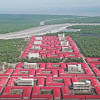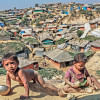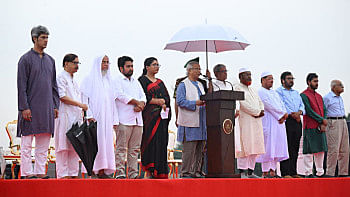Bhasan Char: Better conditions, but home still beckons

When Abdul Hakim landed on a remote island in the Bay of Bengal some 20 months ago, finding a job was his main concern. There were little to no employment opportunities in Bhasan Char when he arrived in the first batch from a cramped Rohingya camp in Cox's Bazar.
"Now I work as a day labourer, earning Tk 400 per day. But I also have options of farming and fishing, so I grow vegetables in the backyard of my house," said the 45-year-old Rohingya man over the phone from the island.
Hakim is one of 30,000 Rohingyas who have so far been shifted to Noakhali's Bhasan Char in multiple phases from the Rohingya camps in Ukhia and Teknaf. The government started relocating the population in December 2020 to provide them with a better life and reduce the loads on the camps.
Formed within the last 20 years by the silt at the mouth of the Meghna River, the island currently has 120 brick-built cluster villages and 120 cyclone shelters. Bangladesh Navy developed the island under a Tk 3,100-crore housing project funded with taxpayers' money.
The project was taken after some 750,000 Rohingyas fled a brutal military crackdown in Myanmar's Rakhine and took shelter in Cox's Bazar in the months following August 2017. They joined some 300,000 other Rohingyas, who had fled previous waves of violence in Rakhine.
As today marks the fifth year of the largest exodus, around 1,000 more Rohingyas are scheduled to arrive at Bhasan Char.
The quiet, calm and isolated island with a few shops, Bhasan Char has seen a massive change with around a hundred small shops being set up by the refugees. A shopping mall has also been built in Bhasan Char.
"When I first came here, there was no sign of life, only structures. Now the island is bustling," said Amzad Ali, who came to the island last year.
Currently, a total of 56 local and international NGOs, including the United Nations, are working here in various sectors despite the UN not being involved in the Bhasan Char project at the initial stage.
However, Rohingyas have been urging to get permission for movement between Cox's Bazar and Bhasan Char, a demand that has the United Nations' support.
Following the demand, around 2,500 Rohingyas have already gone to Cox's Bazar and returned to the island, said officials.
"This helps a lot to mobilise the Rohingya population to come to Bhasan Char. Now more of them are interested to come here," Commodore Rashed Sattar, project director of Ashrayan-3 Project -- popularly known as the Bhasan Char project -- told this correspondent.
He mentioned that another challenge was to create employment opportunities, which has seen great success so far.
A local electronic manufacturing company trained around 100 Rohingya people in assembling electronic parts.
"Currently, 500 Bhashan Char residents working in the company's factory there in different capacities," he said.
However, despite every good thing about Bhashan Char, homesickness follows.
Nurul Kalam, another Rohingya resident in Bhashan Char, said despite having a better life and other facilities on the island, he wants to go back to Myanmar.
"Life is more or less settled and secure here. But I still want to go back to my homeland at the soonest possible time," said Nurul.

 For all latest news, follow The Daily Star's Google News channel.
For all latest news, follow The Daily Star's Google News channel. 








Comments